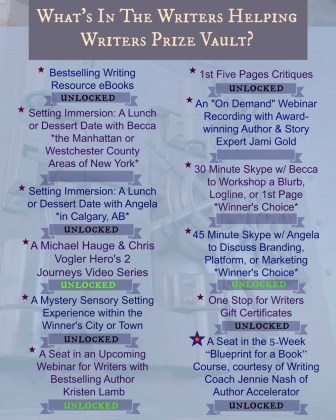Angela Ackerman's Blog: Writers Helping Writers, page 134
July 2, 2016
Emotional Wound Entry: Discovering One’s Sibling Was Abused
When you’re writing a character, it’s important to know why she is the way she is. Knowing her backstory is important to achieving this end, and one of the most impactful pieces of a character’s backstory is her emotional wound. This negative experience from the past is so intense that a character will go to great lengths to avoid experiencing that kind of pain and negative emotion again. As a result, certain behaviors, beliefs, and character traits will emerge.
 Characters, like real people, are unique, and will respond to wounding events differently. The vast array of possible emotional wounds combined with each character’s personality gives you many options in terms of how your character will turn out. With the right amount of exploration, you should be able to come up with a character whose past appropriately affects her present, resulting in a realistic character that will ring true with readers. Understanding what wounds a protagonist bears will also help you plot out her arc, creating a compelling journey of change that will satisfy readers.
Characters, like real people, are unique, and will respond to wounding events differently. The vast array of possible emotional wounds combined with each character’s personality gives you many options in terms of how your character will turn out. With the right amount of exploration, you should be able to come up with a character whose past appropriately affects her present, resulting in a realistic character that will ring true with readers. Understanding what wounds a protagonist bears will also help you plot out her arc, creating a compelling journey of change that will satisfy readers.
NOTE: We realize that sometimes a wound we profile may have personal meaning, stirring up the past for some of our readers. It is not our intent to create emotional turmoil. Please know that we research each wounding topic carefully to treat it with the utmost respect.
Discovering One’s Sibling Was Abused
Examples:
witnessing the abuse first hand (seeing or hearing it occur)
discovering the abuse after the fact only when one’s sibling opens up about it
knowing one’s sibling is taking the abuse to protect oneself or other loved ones
hearing a rumor about abuse involving one’s sibling and discovering it to be true
being abused and realizing up to this point, one’s sibling has allowed herself or himself to been victimized in order to shield
discovering the abuse when one’s sibling attempted suicide and left a note
being told by a friend or family member that one’s sibling was abused
Basic Needs Often Compromised By This Wound: safety and security, love and belonging, esteem and recognition
False Beliefs That May Be Embraced As a Result of This Wound:
This is my fault, I should have done something
I should have protected my sibling
I should have seen what was happening
I failed as a sister/brother and should have shielded them from this
I should have been stronger and taken the abuse myself
I am unworthy of love, respect, and trust
I can’t help others; I will only fail or let them down
I cause other people pain and shouldn’t be close to anyone
I am weak and deserve only pain and unhappiness
I can never make up for my failure, I deserve the darkness of this guilt
I can’t protect the people I love
I don’t deserve to feel safe and secure, not when my sibling had that taken away
Positive Attributes That May Result: affectionate, alert, appreciative, courageous, empathetic, generous, honest, honorable, humble, introverted, loyal, kind, merciful, nurturing, obedient, observant, patient, perceptive, persistent, private, protective, resourceful, responsible, spiritual, supportive, tolerant, unselfish
Negative Traits That May Result: confrontational, cowardly, humorless, inhibited, insecure, nervous, paranoid, promiscuous, reckless, self-destructive, subservient, suspicious, timid, uncommunicative, violent, volatile, withdrawn workaholic, worrywart
Resulting Fears:
fear of trusting people
fear of being responsible for others
fear of letting others down
fear of one’s children also being abused
fear of misreading people and missing a threat
fear of being left alone with people who make one uncomfortable or who intimidate
fear of helplessness
fear of secrets or fear that secrets are being kept from oneself
fear of exploitation
Fear of people who trigger reminders of the “type” of abuser
Possible Habits That May Emerge:
subservience to one’s sibling to make up for a perceived past failing (the character will feel guilt, even if they were not in a position to help or didn’t know it was occurring
anger and outbursts, even violence
refusing to speak to those who one blames, even if they were unaware themselves of what happened
a desire for revenge
second guessing one’s decisions, especially when one is responsible for others
Growing overprotective of loved ones
Digging for secrets if one suspects they are there, seeing even the smallest one as toxic
wanting to know where one’s loved ones are at all times
placing oneself in risky situations that increase the likelihood one will be hurt out of a deep sense of guilt and believing one deserves it
deep feeling of shame keeping one from being around one’s sibling
self-harm, medicating with alcohol or drugs, or engaging is self-destructive behavior from guilt
TIP: If you need help understanding the impact of these factors, please read our introductory post on the Emotional Wound Thesaurus. For our current list of Emotional Wound Entries, go here.
For other Descriptive Thesaurus Collections, go here.
Save
The post Emotional Wound Entry: Discovering One’s Sibling Was Abused appeared first on WRITERS HELPING WRITERS®.
June 29, 2016
Taking the Audiobook Plunge? Read This First
Super thrilled to have author Diane Rinella with us today, who has a ton of experience with audiobooks and has put together some great information for anyone looking to take the leap. Audiobooks are a completely different animal than ebooks or print, and this post can save your a lot of time, heartache, and money.
Plunging Into Audiobooks
 I love audiobooks. Many find the convenience of listening to them nearly anytime and anywhere a virtue. But for me, the appeal is how I get to listen to another person’s dream.
I love audiobooks. Many find the convenience of listening to them nearly anytime and anywhere a virtue. But for me, the appeal is how I get to listen to another person’s dream.
For years, hearing your book come to life was a fantasy reserved for top-selling authors. But we live in an amazing age where technology makes yesterday’s imaginings today’s reality. Not unlike how Amazon helped drive the Indie ebook revolution with Kindle Direct Publishing, they are at it again with Audio Creation Exchange. However, much like the trials of ebook publishing, sharing your book with listeners is not as simple as reading it aloud. Thus before hiring a producer, or biting the bullet and self-producing, a few things are worth considering.
Before moving forward, let’s define a few roles:
Producer – The person who records and masters the material. This may be the same person as the narrator/voice actor.
Narrator – The general term for the person performing your book.
Voice Actor – May also be referred to as narrator. However, this person can also bring multiple voices to life and expresses emotion.
FIRST, DON’T RUSH INTO THINGS
Take a deep breath, because there are a few things to consider before you look for a producer. Remember everything you did (such as editing and formatting) to give consumers the best reading experience? Now you need to determine how to give them the best listening experience.
Pay Per Finished Hour or Royalty Split
Just like any other project, what you can afford will guide your decisions. ACX offers a great program called Royalty Share. The author provides the book, the producer records it, the author approves it—both split the proceeds. However, some producers will only accept projects paid by the finished hour. (If the producer spends forty hours on a project that comes in at eight hours long, you pay for eight hours.) All sales proceeds go to you. However, a finished hour can range between $50 and $200. Most novels are eight to ten hours long. Will your budget cover $400 to $1600? If not, you might consider a royalty share or self-production. (We will return to that can of worms later.)
Narration versus Acting
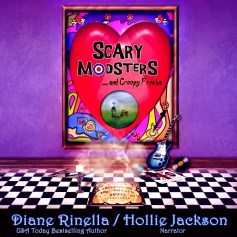 Would your book benefit most from narration, or should a voice actor bring the characters to life? Are you dead set about how the narrator, or any of the characters, should sound? These questions led me to a dilemma. Scary Modsters … and Creepy Freaks, was written in three, first person POVs, two of which are male and one of those is from East London.
Would your book benefit most from narration, or should a voice actor bring the characters to life? Are you dead set about how the narrator, or any of the characters, should sound? These questions led me to a dilemma. Scary Modsters … and Creepy Freaks, was written in three, first person POVs, two of which are male and one of those is from East London.
I wanted multiple actors, not to mention a proper accent. However, I quickly found my dream scenario required hiring four people and heavy editing. Since the price tag would be at least a hefty $400 per finished hour, the only cost-effective option was to go with one, very talented producer. Fortunately, Hollie Jackson came to the rescue. Hollie is a partner worth her weight in gold. Partners can make or break a project. (More on partnerships later.)
Books Are Meant To Be Read, Not Heard
Writers often give visual clues that do not translate into audiobooks. Are you willing to consider changes that improve the experience, or must the audio version match the original text without fail? Some things can enhance the listening experience, either by adding or removing them. One of those is dialog tags.
 The visual characteristics of a quoted sentence ending and a new paragraph beginning with another quoted line is an accepted cue a new person is speaking. If the conversation is two-sided, a dialog tag may not have been deemed necessary. If an actor uses vocal changes to represent new characters, a dialog tag may still be unnecessary. However, in the case of straight narration, where all voices sound alike, adding one would eliminate confusion.
The visual characteristics of a quoted sentence ending and a new paragraph beginning with another quoted line is an accepted cue a new person is speaking. If the conversation is two-sided, a dialog tag may not have been deemed necessary. If an actor uses vocal changes to represent new characters, a dialog tag may still be unnecessary. However, in the case of straight narration, where all voices sound alike, adding one would eliminate confusion.
Conversely, when a character’s speech spans multiple paragraphs, writers often add the clue, “he continued.” However, when a character is read with a distinct voice, not only do these clues become unnecessary, they become pace-breaking distractions.
Italics are often used to stress a word or to reflect deep thought. Stressing these items is part of a narrator’s job. However, quoted italics can reflect hearing a person’s thoughts, such as during telepathy. If you did not use dialog tags such as, “he thought”, translating the idea of telepathy into audio may be difficult, and changes should be considered.
Consider making listening-enhancing revisions before submitting your manuscript.
Ready? Let’s Dive In!
Let’s get to the fun stuff! There are many ways to create an audiobook. To keep this simple, I will focus on two methods; using ACX to hire a producer, and the self-production method—both of which I have experienced.
ACX: MAKING HIRING & PARTNERSHIP DECISIONS
Whether you seek a royalty split or to hire someone per finished hour, here are some things to keep in mind when pursuing talent and when listening to auditions:
Reputation – Simply stated, never jump into a partnership without ensuring it will be a strong one, and never hire a person you don’t want to work with. I turned down numerous offers for many reasons—some of which were less than stellar reputations for delivering the basics. Do not be afraid to ask your friends for recommendations or producers for references.
Voice and Characterization – Does the narrator have an appealing tone? Does she “feel right” for the part? Is the accent appropriate yet understandable? Determining voices and narration style before signing a contract is key. While the writer must be comfortable with the presentation, nitpicking over a performance is best saved for the actor. Both need to set realistic expectations. My partner, Hollie Jackson, summed the characterization process beautifully. “I truly think the absolute biggest thing is to trust your narrator, particularly in regards to characterization. If an author can provide notes to give us a direction to point our voices, it takes a huge load off of us trying to figure out how a particular character sounds. But by that same token, sometimes a character will strike a particular reference chord, and things might sound a little different compared to the voice in the writer’s head. Being able to work with that is a huge part of the process.”
 Quality/Mastering (hiss, pops, clicks, timing) – Inadequate mastering can ruin a brilliant performance. While ACX has strict submission requirements regarding noise floor (the level at which hiss is heard) and level variation (a whisper and a yell need to be close in volume), there are no stated requirements regarding pops and clicks. Listen for these, along with timing. Timing is not only the pace at which a book is read, but also how lines are delivered. For comedy, the outstanding timing of Robin Williams and George Burns had us rolling in the aisles. Dramatic timing is just as important. The demo’s timing should fit the book’s genre.
Quality/Mastering (hiss, pops, clicks, timing) – Inadequate mastering can ruin a brilliant performance. While ACX has strict submission requirements regarding noise floor (the level at which hiss is heard) and level variation (a whisper and a yell need to be close in volume), there are no stated requirements regarding pops and clicks. Listen for these, along with timing. Timing is not only the pace at which a book is read, but also how lines are delivered. For comedy, the outstanding timing of Robin Williams and George Burns had us rolling in the aisles. Dramatic timing is just as important. The demo’s timing should fit the book’s genre.
Eliminate Surprises – If part of the audition seems unfitting, yet you still suspect the voice actor could be a match, express your concerns and request a new audition. Re-reads are not unreasonable and may save both the writer and producer many headaches.
Building A Partnership – I cannot stress the importance of this enough, especially if you wish to do multiple projects with the same person. I tell Hollie all the important things up front and then let her work magic. As a fellow actress, I completely agreed when she said, “Micromanagement is the hugest creative buzzkill around.” However, she also respects my concerns and will quickly make changes when things go awry. The bottom line is, if you are concerned that a producer will not give you the end results you desire, either find someone else or self-produce.
DIY: SELF-PRODUCTION
I will preface this by saying I have decades of acting experience—stage, screen, and voice. Since my husband is an Indie film director/producer, resources are at my disposal. Still, it took quite a bit of working with sound engineers before I could produce a solid audiobook.
 The absolute basics to home recording include: a room with a low noise floor (I lined the quietest room in my house with moving blankets.), proper equipment (A good microphone, a pop filter, a pre-amp, a Mudguard, and a stand will cost several hundred dollars.), and editing software (I pay $20 a month to use Adobe Audition.).
The absolute basics to home recording include: a room with a low noise floor (I lined the quietest room in my house with moving blankets.), proper equipment (A good microphone, a pop filter, a pre-amp, a Mudguard, and a stand will cost several hundred dollars.), and editing software (I pay $20 a month to use Adobe Audition.).
In a nutshell, recording two takes without outside sounds (birds, pets, kids, cars, planes) generally gets you what you need. Edit these into one good take before removing pops, clicks, and rustling. In my case, I also have to remove background hiss. Top all of this off with balancing the levels. (By the way, you might want to consider that it takes Hollie about two hours to record and master one finished hour while it takes me three or four. Be prepared to invest some time.)
Have I scared you out of the self-production method yet? Learning the recording and mastering process is a hurdle, yet producing audiobooks is simple compared to other types of sound engineering. While I highly recommend ACX’s video series on recording, the installment on mastering falls short of providing usable information. Thus, you might want to consider hiring someone to master your files. However, if you really want to give it a go, ACX does have an Audio Masters class.
HYBRID: SELF-PRODUCTION & HIRING A PRODUCER
ACX does not offer the option to hire a producer, only to master files. Thus, you will need to pay someone outside of their system. Professional sound services can be expensive and offer more than you need for an audiobook. I strongly suggest contacting local filmmaker groups (Here in San Francisco, we have Scary Cow.) or colleges to seek emerging talent at a reasonable rate. Though there are also services that will perform this task for you, I’ve yet to find an author who has done this, thus I cannot make a recommendation.
This is a lot to digest, but once you get your head around the process, it’s actually a lot of fun. I have to say that having done this with a partner and now producing myself, I prefer the partner route. Then again, I struck gold with Hollie. With a little determination to find the right person, you can too. Either way, bringing your book to life is a rush akin to the time you held your first novel in your hands!
The benefits to partnering with an experienced producer are no learning curve, a faster turn around, often better talent than an inexperienced performer can provide, and a built-in audience, as many often have their own fanbase. The con is you may not get the creative control you desire.
The benefit to self-production is full creative control. The cons may include steep learning curves in voice acting, recording, and mastering.
Diane Rinella
 Enjoying San Francisco as a backdrop, the ghosts in USA Today Bestselling Author Diane Rinella‘s one hundred and fifty-year old Victorian home augment the chorus in her head. With insomnia as their catalyst, these voices have become multifarious characters that haunt her well into the sun’s crowning hours, refusing to let go until they have manipulated her into succumbing to their whims. Her experiences as an actress, business owner, artisan cake designer, software project manager, Internet radio disc jockey, vintage rock ‘n’ roll journalist/fan girl, and lover of dark and quirky personalities influence her idiosyncratic writing. Hang out with her on Twitter, Facebook & Goodreads and find more audiobook projects here.
Enjoying San Francisco as a backdrop, the ghosts in USA Today Bestselling Author Diane Rinella‘s one hundred and fifty-year old Victorian home augment the chorus in her head. With insomnia as their catalyst, these voices have become multifarious characters that haunt her well into the sun’s crowning hours, refusing to let go until they have manipulated her into succumbing to their whims. Her experiences as an actress, business owner, artisan cake designer, software project manager, Internet radio disc jockey, vintage rock ‘n’ roll journalist/fan girl, and lover of dark and quirky personalities influence her idiosyncratic writing. Hang out with her on Twitter, Facebook & Goodreads and find more audiobook projects here.
Hollie Jackson
 Taking her own love of storytelling, not just for her own work, but that of others, Hollie (aka Narratrix) found her true calling in the vocal booth. From the innocent to the risqué, the snarky to the serious, Hollie’s voice brings characters of all types to vibrant, compelling life, letting you sit back and allow the words to wrap around you and work their resonant magic. With over 300 audiobooks narrated and produced to date, Hollie enjoys an eclectic range of genres and has worked with authors/publishers who are both Indie and NYT/USA Today Bestselling.
Taking her own love of storytelling, not just for her own work, but that of others, Hollie (aka Narratrix) found her true calling in the vocal booth. From the innocent to the risqué, the snarky to the serious, Hollie’s voice brings characters of all types to vibrant, compelling life, letting you sit back and allow the words to wrap around you and work their resonant magic. With over 300 audiobooks narrated and produced to date, Hollie enjoys an eclectic range of genres and has worked with authors/publishers who are both Indie and NYT/USA Today Bestselling.
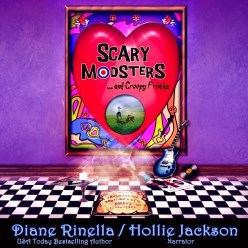 Want to check out Scary Modsters yourself? here’s a soundbite:
Want to check out Scary Modsters yourself? here’s a soundbite:
Rosalyn possesses a sunny personality that is laced with quirks. Although she seeks acceptance in a world where she lives out of time, what she gets is ridiculed for her eclectic wardrobe and unconventional music collection.
One fateful night, Rosalyn bewitches Niles, a stylish man whose offbeat character perfectly complements her own. Unfortunately, he possesses a critical flaw that means relationship suicide for him and pretty much anyone.
While under the influence of insomnia-impaired judgment, Rosalyn summons Rock ‘n Roll deity Peter Lane back from the dead. Not only does he spin her hormones into a frenzy, Peter is also the precarious puzzle piece that brings sense into her world. When Niles learns that he can overcome his life-long challenge by helping Peter avenge his death, how far will he go to secure Rosalyn’s heart?
Have an Audiobook Production question for Diane? Her brain is stuffed with knowledge and experience, so let us know in the comments.
Save
Save
Save
Save
Save
Save
The post Taking the Audiobook Plunge? Read This First appeared first on WRITERS HELPING WRITERS®.
June 27, 2016
Making your Character Shine From Page One
Happy Monday, everyone! Angela and I have been so focused lately on the launch of our setting thesaurus books, it feels like that’s all we’ve been doing for months. So we’re excited to get back to the normal Writers Helping Writers routine with a guest post by Kate Foster. She’s here today to talk about how to get readers falling in love with your characters on the very first page.
Plot and characters are both vitally important to a good story, but I’ve always been drawn to the people in the story more than to the story itself. In my opinion, characters are the all-important key to sinking your teeth into your readers and tearing out their hearts. Dramatic, of course, but fundamentally, it’s the reader’s heart you want to win over, and the characters are your bow and arrow. Get them right, and you’re on a pretty smooth course to writing an engaging book.
After you’ve profiled your character and know them better than your own family members – and definitely do this detailed, time-consuming background work; I promise it will make all the difference – it’s time to put pen to paper and let them take over your words. Because it’s no longer you telling the story; your character should be in the driving seat.

What makes your character different or interesting?
But don’t wait until the end of chapter one, or chapter two, or even page two to showcase their personalities, who they are, and what they do. No, smash it straight in there on page one, paragraph one. Lure, hook, intrigue. Let the reader hear the character and get to know them right off the bat; give your audience an important detail as to who this person is, what he or she does, what’s happened in the past.
To clarify this, here are a few examples of authors who showed readers on the very first page who they were getting involved with.
[image error][image error]‘Bradley Chalkers sat at his desk in the back of the room—last seat, last row. No one sat at the desk next to him or at the one in front of him. He was an island.’ (There’s a Boy in the Girl’s Bathroom—middle grade, contemporary— by Louis Sachar)
Bam! From the very first line, we know in three sentences that no one wants to sit with Bradley, and probably because no one likes him. We know how Bradley feels about this too: isolated. And just like that, we’re touched, we’re sucked in. We’re sad. We want to know why. What is it about Bradley that’s so wrong, so terrible that he sits at the back of the class, alone?
[image error]
‘The door would splinter off its hinges with a swift kick from his boot like the previous dozen he’d blasted in over the years. But bashing in doors was noisy and drew the wrong kind of attention.’ (Poor Boy Road by James L. Weaver)
Straight away we know we’re dealing with a tough guy—someone violent, someone who’s been doing this for a while. Kicking in doors isn’t an unusual experience for this character, which sets him apart from normal people as, let’s face it, most of us use the doorknob. But we also know that he doesn’t want to get caught. So, who is he? Is he working alone? Voluntarily? Is this his day job?
What these authors have done in their opening lines is dropped in sneaky clues to show (rather than tell) that their characters are different—definitely not run-of-the-mill—which prompts the reader to start asking questions. They’ve injected intrigue and interest in their first pages. And this is essential to make a reader keep reading. What authors mostly want is for their readers to invest time, and money, into their characters. Making this happen from the very first page is critical, and with deft characterization, it’s fairly simple.
As the book opens into that life-changing moment, ask yourself:
How can I show the reader that my character is different than other characters? What’s unique about him/her, what’s important for the reader to know?
How can I show the reader my character’s personality and voice through his or her reactions (physically and mentally) to the current scene?
What emotion is my character experiencing as the book opens?
What secret is my character hiding that sits at the root of his/her motivation?
Questions like these will help you to really know your characters before you write your book. And knowing them well—their flaws, strengths, habits, speech patterns, every puzzle piece from the past that has created this imaginary person—is important to being able to make them real, make them whole. Only then can they shine from that very first page.
Bio
 Kate is an Englishwoman who lives on the sunny Gold Coast in Australia with her tribe of ‘lads’ – three sons, husband and male spoodle! She is the editorial director at Lakewater Press as well as a freelance developmental editor and loves nothing more than teaming up with authors to improve their raw manuscripts. She has been a writing judge and mentor for numerous writing contests, including Freshly Squeezed Reads, Nest Pitch, Fic Fest and Pitch Wars. Kate also dabbles a little with her own writing! You can find her online at www.katejfoster.com, www.katefosterauthor.com, on Twitter, and Facebook.
Kate is an Englishwoman who lives on the sunny Gold Coast in Australia with her tribe of ‘lads’ – three sons, husband and male spoodle! She is the editorial director at Lakewater Press as well as a freelance developmental editor and loves nothing more than teaming up with authors to improve their raw manuscripts. She has been a writing judge and mentor for numerous writing contests, including Freshly Squeezed Reads, Nest Pitch, Fic Fest and Pitch Wars. Kate also dabbles a little with her own writing! You can find her online at www.katejfoster.com, www.katefosterauthor.com, on Twitter, and Facebook.
*photo courtesy: Pixabay
Save
Save
The post Making your Character Shine From Page One appeared first on WRITERS HELPING WRITERS®.
June 25, 2016
Emotional Wounds Thesaurus: A Family Member’s Suicide
When you’re writing a character, it’s important to know why she is the way she is. Knowing her backstory is important to achieving this end, and one of the most impactful pieces of a character’s backstory is her emotional wound. This negative experience from the past is so intense that a character will go to great lengths to avoid experiencing that kind of pain and negative emotion again. As a result, certain behaviors, beliefs, and character traits will emerge.
Characters, like real people, are unique, and will respond to wounding events differently. The vast array of possible emotional wounds combined with each character’s personality gives you many options in terms of how your character will turn out. With the right amount of exploration, you should be able to come up with a character whose past appropriately affects her present, resulting in a realistic character that will ring true with readers. Understanding what wounds a protagonist bears will also help you plot out her arc, creating a compelling journey of change that will satisfy readers.
NOTE: We realize that sometimes a wound we profile may have personal meaning, stirring up the past for some of our readers. It is not our intent to create emotional turmoil. Please know that we research each wounding topic carefully to treat it with the utmost respect. For this particular wound, there is no doubt that some of you have had personal experience with it, either as someone considering suicide or someone living in the aftermath of a loved one’s suicide. If you are suffering in any way due to a past, planned, or possible suicide, there are people who can help. Just call 1-800-273-TALK (8255) and speak to someone 24 hours a day.

Courtesy: Pixabay
Basic Needs Often Compromised By This Wound: physiological needs, safety and security, love and belonging, esteem and recognition
False Beliefs That May Be Embraced As a Result of This Wound:
This is my fault.
If I had been X (more available, a better daughter/son/spouse, etc.) he/she wouldn’t have done it.
I should have seen the signs.
If she had really loved me she wouldn’t have done this.
Why didn’t he confide in me? Maybe there’s something wrong with me.
I’m incapable of true intimacy.
I’m good enough when life is light and easy, but when things get tough, I’m not someone that people turn to.
Positive Attributes That May Result: affectionate, appreciative, nurturing, observant, pensive, private, proactive, responsible, sentimental, supportive
Negative Traits That May Result: addictive, apathetic, callous, compulsive, confrontational, cynical, fussy, hostile, humorless, inhibited, insecure, irrational, martyr, morbid, needy, obsessive, rebellious, reckless, resentful, self-destructive, uncooperative, volatile, withdrawn
Resulting Fears:
The fear that one will miss the signs and it will happen again
The fear of never being “good enough” for one’s loved ones
The fear of never achieving true intimacy with others
The fear that one is untrustworthy or incapable.
The fear that there is something inherently wrong with oneself.
Possible Habits That May Emerge:
Withdrawing from loved ones
Maintaining surface relationships as a way of avoiding potential hurt
Becoming overly needy and clingy with loved ones
Becoming hyper vigilant with loved ones
Obsessively watching for signs
Overcompensating for whatever one feels guilty about (being less or more strict, smothering loved ones in an effort to pay closer attention, etc.)
Trying to be “better” in whatever way one felt was lacking (paying more attention, being more obedient, etc.)
Becoming more observant
Falling into depression
Having suicidal thoughts or attempting suicide
Self-medicating
TIP: If you need help understanding the impact of these factors, please read our introductory post on the Emotional Wound Thesaurus. For our current list of Emotional Wound Entries, go here.
For other Descriptive Thesaurus Collections, go here.
The post Emotional Wounds Thesaurus: A Family Member’s Suicide appeared first on WRITERS HELPING WRITERS®.
June 22, 2016
Settings and Symbolism
Wow, you guys. What an amazing week!
A huge thank you to everyone who participated in our big ROCK THE VAULT giveaway and to all those who shared the #myfavoritethesaurus pictures. I think we made thesauruses everywhere officially COOL. And also an enormous thank you to all the wonderful people who helped out with our launch, especially the Thesaurus Club (our street team). We are so blessed to have so many wonderful people support us. If you want to find some of these folks and their blogs, check them out here. 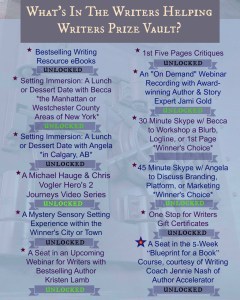 While we didn’t get to the 500 pictures shared that would unlock all prizes in the vault, we did see about 300 of them online, and so Angela and I, being the softies we are, unlocked most of the prizes. Winners have been drawn and are being notified. Once we have acceptance from these lovely people, Angela will post the list.
While we didn’t get to the 500 pictures shared that would unlock all prizes in the vault, we did see about 300 of them online, and so Angela and I, being the softies we are, unlocked most of the prizes. Winners have been drawn and are being notified. Once we have acceptance from these lovely people, Angela will post the list.
And for those of you who happened to buy our new books this week, thank you for welcoming our youngest offspring into the world! We hope that you have many light bulb moments when it comes to description and maximizing your settings.

They grow up so fast. *sniff sniff*
While Rock the Vault was a blast, Angela and I would be lying if we said we weren’t looking forward to getting back to a more normal routine. And today, that means me posting at the unbelievably awesome Kristen Lamb’s blog.
If you’re not familiar with Kristen, rectify that posthaste by following her on every conceivable social media platform. She’s one of the most prolific and knowledgeable bloggers out there as well as being an expert on all things networking and branding. If you’ve got a few minutes, drop in and see how Symbolism and the Setting Make a Perfect Marriage.
Happy Writing!
Save
Save
The post Settings and Symbolism appeared first on WRITERS HELPING WRITERS™.
June 20, 2016
Rock The Vault: Final Day To Enter The Draw
Happy writing!
This is it, the last day. Here’s where we stand with the Prize Vault:
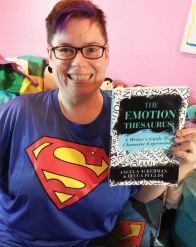
Via Cheryl Rainfield
There are still some prizes to unlocked, so please keep sharing your #myfavoritethesaurus pictures on Facebook, Twitter and Instagram.
The more people share, the more prizes are unlocked!

via Knyghtshadeart @ instagram
Have you entered the draw? Here’s the Rock the Vault entry FORM.
And please visit our Prize Page for the full breakdown of all these unusual and wonderful prizes created just for writers!
You can win books, premiere writing classes with expert like Kristen Lamb, go for lunch with Becca or I…even a fun “mystery” experience in your own city or town.
 And you definitely want to get your name in for Author Accelerator’s Blueprint For A Book 5-week course.
And you definitely want to get your name in for Author Accelerator’s Blueprint For A Book 5-week course.
Imagine what could you accomplish with personalized coaching for 5 weeks. What you learn will change your whole writing career. Click the link about to read more about the prize, and make sure you select this prize option on the Rock the Vault entry form.
So join us in celebrating our love of words, and our love of writing. Share a picture you’ve taken of a thesaurus online (any thesaurus, not just one of ours). Use the #myfavoritethesaurus hashtag so we can track it.
Let’s work together to unlock all the prizes by sharing 500 #myfavoritethesaurus pictures!
Save
Save
Save
Save
Save
Save
Save
Save
Save
Save
Save
Save
Save
Save
Save
Save
Save
The post Rock The Vault: Final Day To Enter The Draw appeared first on WRITERS HELPING WRITERS™.
June 17, 2016
New Tools, New Articles, and an Invite
Hi everyone,
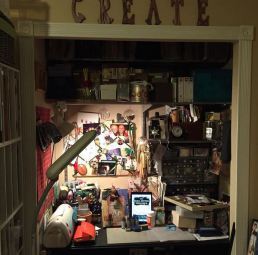
allianne1965 @ instagram
Becca and I are in the Setting mindset, as you can well imagine, and it has been a crazy two weeks of posting about the setting, sharing new tools to help with setting, and of course, celebrating the setting.
So here are some links you may or may not know about.
NEW TOOLS:

Beth Overmyer @ twitter
First of all, we’ve uploaded 4 new tools to the Tools For Writers Page. These Setting tools are straight from our books so that you can download and print blanks if you like.
We have a Emotional Value Tool, a Setting Planner Tool, a Setting Checklist (you want this, trust me), and a Setting Exercise sheet.
Just scoot over to our tools page–they are all listed at the top, so very easy to find. 
New Tools, New Articles, and a Rock The Vault Update
Hi everyone,
 We’re at the midpoint of our launch festivities and enough #myfavoritethesaurus pictures have been shared to unlock some more prizes. Have a look at what’s been added! Have you entered yet?
We’re at the midpoint of our launch festivities and enough #myfavoritethesaurus pictures have been shared to unlock some more prizes. Have a look at what’s been added! Have you entered yet?
There’s still a ways to go, however, so please, keep showing off your #myfavoritethesaurus pictures online.
We’ve seen some real beauties, and I’ll post a few here. If you want to join in on the fun on Facebook, Twitter, or Instagram, pop by this post.

allianne1965 @ instagram
Becca and I are in the Setting mindset, as you can well imagine, and it has been a crazy two weeks of posting about the setting, sharing new tools to help with setting, and of course, celebrating the setting.
So here are some links you may or may not know about.
NEW TOOLS:

Beth Overmyer @ twitter
First of all, we’ve uploaded 4 new tools to the Tools For Writers Page. These Setting tools are straight from our books so that you can download and print blanks if you like.
We have a Emotional Value Tool, a Setting Planner Tool, a Setting Checklist (you want this, trust me), and a Setting Exercise sheet.
Just scoot over to our tools page–they are all listed at the top, so very easy to find. 
June 15, 2016
Building A Story Garden: The Power Of Settings In Fiction
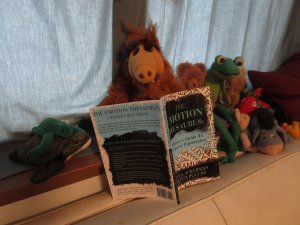
Bish Denham’s #myfavoritethesaurus
Guys, I have to say thanks! We’re just a few days into our launch and your response to these books has been staggering. Becca and I are both so pleased you’re happy with our newest family members.
Thank you for the reviews, the tweets, the recommendations to friends, and oh my, the #myfavoritethesaurus pictures! I am LOVING the pictures you’re taking. Please keep doing it—so much fun!
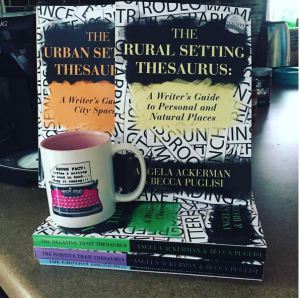
Jade_Eby’s #myfavoritethesaurus
Can I confess something? This was a very nervous release for me. And while every author will tell you nerves never go away, you’d think that ol’ Angela would be a bit more chill seeing as this is her 4th and 5th rodeo. But no, not at all. Poor Becca’s been babysitting a total worrywart for the last few weeks (sorry, Becca!)

Mich’s #myfavoritethesaurus
Up until now, I thought I was a bit freaked out because we’ve had a lot of challenges.
First, someone had this silly idea of doing two books at once again (sigh, me). Double the work at publishing time (nice one, Angela). Second, halfway through writing these books, Becca and I detoured to create One Stop For Writers. And while we are both so thrilled with our unique online library, it meant a year-long break from the Setting Thesaurus. Finding our footing took time.
Finally we had, well, some outsourced production issues that created delays and caused errors. And, Becca and I hadn’t left ourselves enough buffer time to account for this. So everything really was down to the wire.
So yes, all these things have been swimming in Angela’s Dark Matter, adding to the anxiety, but it was only tonight as I sat down with my print copies (which only arrived today), that I realized WHAT was causing my nerves.
It wasn’t the rushing or stressing that we’d missed a typo or two.
It wasn’t flutters over trying to live up to our other books.
It was that I cared so much about getting this right.
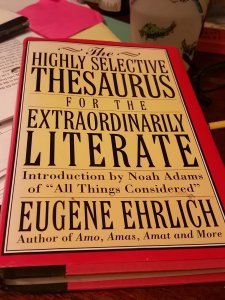
Betsey J’s #myfavoritethesaurus
Setting is often overlooked, passed over in favor of the characters and the plot. For many, setting is just sort of “there.”
We all know learning how to describe the setting so readers feel part of the world is a skill we need. But, here’s the truth: achieving this isn’t enough. Not if we want to transform the story and elevate the characters into complex, rich beings. People who could be real. Who readers could imagine meeting, talking with, and caring about. Maybe even falling for.
Setting is not a backdrop. It isn’t just a jumble of sights and sounds and smells and tastes and textures. It is so much more.
Setting can…
…create conflict or tension
…foreshadow a coming event
…encourage the character to make an emotion-driven action or choice
…remind the character of their past, good or bad
…poke at old wounds
…challenge the character to face his fears
…recreate a wounding event so the character can navigate it successfully and let go of past pain
…deliver important backstory actively
…characterize the story’s cast
…display symbolism or motifs which reinforce a deeper message
…convey a specific mood
…steer the plot
…test the character through obstacles and setbacks
…give the setting an emotional value and deploy emotional triggers
(Oh, and of course, that other big thing…provide descriptive opportunities to make the reader feel part of the story.)
*To print the Setting Checklist above, visit our Tools For Writers Page. 
Building A Story Garden: The Power Of Our Settings

Bish Denham’s #myfavoritethesaurus
Guys, I have to say thanks! We’re just a few days into our launch and your response to these books has been staggering. Becca and I are both so pleased you’re happy with our newest family members.
Thank you for the reviews, the tweets, the recommendations to friends, and oh my, the #myfavoritethesaurus pictures! I am LOVING the pictures you’re taking. Please keep doing it—so much fun!

Jade_Eby’s #myfavoritethesaurus
Can I confess something? This was a very nervous release for me. And while every author will tell you nerves never go away, you’d think that ol’ Angela would be a bit more chill seeing as this is her 4th and 5th rodeo. But no, not at all. Poor Becca’s been babysitting a total worrywart for the last few weeks (sorry, Becca!)

Mich’s #myfavoritethesaurus
Up until now, I thought I was a bit freaked out because we’ve had a lot of challenges.
First, someone had this silly idea of doing two books at once again (sigh, me). Double the work at publishing time (nice one, Angela). Second, halfway through writing these books, Becca and I detoured to create One Stop For Writers. And while we are both so thrilled with our unique online library, it meant a year-long break from the Setting Thesaurus. Finding our footing took time.
Finally we had, well, some outsourced production issues that created delays and caused errors. And, Becca and I hadn’t left ourselves enough buffer time to account for this. So everything really was down to the wire.
So yes, all these things have been swimming in Angela’s Dark Matter, adding to the anxiety, but it was only tonight as I sat down with my print copies (which only arrived today), that I realized WHAT was causing my nerves.
It wasn’t the rushing or stressing that we’d missed a typo or two.
It wasn’t flutters over trying to live up to our other books.
It was that I cared so much about getting this right.

Betsey J’s #myfavoritethesaurus
Setting is often overlooked, passed over in favor of the characters and the plot. For many, setting is just sort of “there.”
We all know learning how to describe the setting so readers feel part of the world is a skill we need. But, here’s the truth: achieving this isn’t enough. Not if we want to transform the story and elevate the characters into complex, rich beings. People who could be real. Who readers could imagine meeting, talking with, and caring about. Maybe even falling for.
Setting is not a backdrop. It isn’t just a jumble of sights and sounds and smells and tastes and textures. It is so much more.
Setting can…
…create conflict or tension
…foreshadow a coming event
…encourage the character to make an emotion-driven action or choice
…remind the character of their past, good or bad
…poke at old wounds
…challenge the character to face his fears
…recreate a wounding event so the character can navigate it successfully and let go of past pain
…deliver important backstory actively
…characterize the story’s cast
…display symbolism or motifs which reinforce a deeper message
…convey a specific mood
…steer the plot
…test the character through obstacles and setbacks
…give the setting an emotional value and deploy emotional triggers
(Oh, and of course, that other big thing…provide descriptive opportunities to make the reader feel part of the story.)
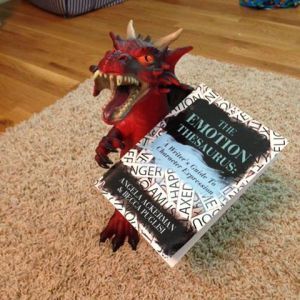
Becca’s #myfavoritethesaurus
In writing these books, Becca and I had our eyes opened to the raw power of the setting.
We realized how picking one for a scene must be a deliberate choice as it can directly influence how events unfold and who our characters become.
We became determined to peel back the curtain in hopes of helping others see what we were seeing: that the setting isn’t simply a piece of the fiction puzzle, it is the story garden where everything grows.
So tonight, as I looked through the two books, I grew calmer. I believe we did what we set out to do: nudge writers to think deeper about the setting, and how to use it to do more.
Because setting is all about “being” more. 
ROCK THE VAULT UPDATE:
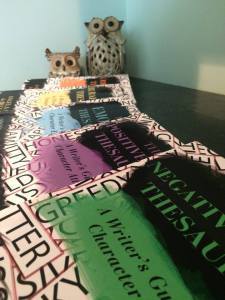
Angela’s #myfavoritethesaurus
Thanks to the pictures your sharing online with the #myfavoritethesaurus hashtag, a new prize has been unlocked: the Hero’s 2 Journeys video series with Michael Hauge and Chris Vogler. But there are still so many prizes to be unlocked!
So let’s see some more of your #myfavoritethesaurus pictures. We’re still a long way from 500 pictures, which will unlock the entire vault!
To enter to win prizes from the vault, fill out this FORM.
To read up on the prizes & who is eligible, go HERE.
To find out how to help unlock the prize vault, visit THIS POST.
Can’t wait to see your next #myfavoritethesaurus picture!
Save
Save
Save
Save
Save
The post Building A Story Garden: The Power Of Our Settings appeared first on WRITERS HELPING WRITERS™.
Writers Helping Writers
- Angela Ackerman's profile
- 1014 followers


